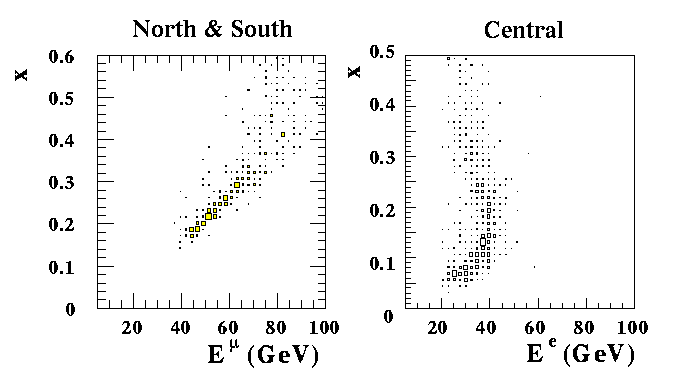 as well as its abundance.
Its ratio to d quark in the proton is approximately
as well as its abundance.
Its ratio to d quark in the proton is approximately



The pol-DIS experiments are not sensitive to the separation of anti-quark from
quark, since photon couples to the square of electric charge of particles.
Furthermore,
current flavor decomposition has to assume flavor SU(3) more or less.
Therefore the measurement of anti-quark polarization and flavor decomposition
will improve the knowledge on the spin of the nucleon significantly.
It should be mentioned that lepton-proton scattering data are highly dominated
by u quark distribution because of the weight of  as well as its abundance.
Its ratio to d quark in the proton is approximately
as well as its abundance.
Its ratio to d quark in the proton is approximately

The replacement of the proton target by deuteron reduces the ratio, thus enhances down quark contribution, to only 2. Because of this insensitiveness to d quark distribution, currently available polarized parton distributions differ especially in valence d polarization [24,25].
The parity violating asymmetry  for W production is sizable
and presented at LO as
for W production is sizable
and presented at LO as

For  production, the u and d should be exchanged.
Obviously the asymmetry is just the linear combination of the
quark and anti-quark polarization. Furthermore, the flavor in the reaction
is almost fixed. Thus flavor decomposition is possible.
production, the u and d should be exchanged.
Obviously the asymmetry is just the linear combination of the
quark and anti-quark polarization. Furthermore, the flavor in the reaction
is almost fixed. Thus flavor decomposition is possible.
For the complete reconstruction of the partonic kinematics
for the W boson production in the leptonic decay channel,
detection of missing energy, which is presumably
the energy carried by neutrino, is desirable. Because both PHENIX
and STAR are not hermetic for all types of particles ( , etc), the reconstruction is impossible.
As shown in the left plot in Figure 5, however,
there is a good correlation
between the muon energy and momentum fraction carried by the incident
quark,
, etc), the reconstruction is impossible.
As shown in the left plot in Figure 5, however,
there is a good correlation
between the muon energy and momentum fraction carried by the incident
quark,  . This correlation is due to the angular distribution of
decay lepton in the W rest frame originated from the V-A nature of the
weak process.
In the limit of negligible
. This correlation is due to the angular distribution of
decay lepton in the W rest frame originated from the V-A nature of the
weak process.
In the limit of negligible  of W,
of W,
Since  distribution follows
distribution follows
 ,
the first term in Eq. (14) dominates and a good correlation
between
,
the first term in Eq. (14) dominates and a good correlation
between  and
and  is obtained. Once
is obtained. Once  is determined
is determined
 can be deduced from Eq. (13) in
good approximation.
can be deduced from Eq. (13) in
good approximation.
In the case of electrons detected in Central Arm, the sample are
biased in decay angle  due to the
due to the
 -coverage and both terms in Eq. (14) equally
contribute. Those are, however, useful in selecting existing models
on quark and anti-quark helicity distributions.
-coverage and both terms in Eq. (14) equally
contribute. Those are, however, useful in selecting existing models
on quark and anti-quark helicity distributions.

Figure 5: Correlation plot for energy of high- leptons and momentum
fraction carried by incident quark. Left plot is for the muons detected in
North and South Muon Arm, and right plot is for the electrons
detected in Central Arm.
leptons and momentum
fraction carried by incident quark. Left plot is for the muons detected in
North and South Muon Arm, and right plot is for the electrons
detected in Central Arm.
Using the muon sample which is divided into several energy bins thus x-bins, we have estimated the sensitivities of our measurements only with statistical error. Results are over-plotted on two of the model predictions for polarized structure functions [24,25] in Figure 6. Error bars indicate the expected statistical errors. Our measurement will be quite sensitive to both quark and anti-quark helicity distributions, though further studies are needed to minimize the background contributions.


